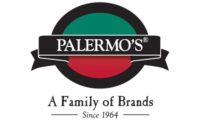Over the past four months since our last analysis of the pizza category, retail sales have taken a slight dip. Frozen pizza dollar sales were down 0.75 percent for the 52 weeks ending January 22, 2017 to $4.6 billion, per IRI, Chicago. Only one company has maintained positive performance, with Palermo Villa up 4.84 percent to $122.9 million, anchored by its Screamin’ Sicilian brand (up 9.82 percent in dollar sales to $70.9 million)—a testament to the staying power of the super-premium segment. Private label is also still capturing growth, up 8.95 percent to $580.3 million.
Other standouts in frozen pizza for the period include The Schwan Food Co. brand Tony’s (up 14.16 percent to $77.3 million) and Nestlé brand Lean Cuisine (up 16.82 to $69.9 million).
Frozen pizza crusts and dough likewise took a slight hit, down 0.32 percent to $19.7 million, per IRI, while shelf-stable pizza crusts and shells dropped 4.89 percent to $107.9 million. Of the top five brands in frozen pizza crusts and dough, only gluten-free baker Against the Grain Gourmet saw a gain (up 17.11 percent to $1.1 million). It’s notable that Against the Grain bakes three kinds of cheese directly into its gluten-free crust. But the clear winner in frozen crusts and dough for the period was private label, rising a significant 50.62 percent in dollar sales to $4.0 million. Damascus Bakery is the standout in the top five shelf-stable crust brands, up 77.77 percent to $4.2 million.
The freshness perception is paying off in refrigerated crusts and dough, up 10.45 percent to $96.3 million. General Mills sits in the No. 1 slot of the segment with its iconic Pillsbury brand, up 4.67 percent to $47.3 million and a 49.13 percent share of the segment. Private label trails at No. 2, up 19.21 percent to $32.5 million.
Slices of interest
The pizza category has seen a wide range of innovative products within the past year or so. Of particular note has been the super-premium offerings from Palermo Villa, which first helped define this segment with its Screamin’ Sicilian line, and then with its Urban Pie line made on a croissant-inspired crust. The company has since extended its Screamin’ Sicilian line with Stromboli products.
Bolder, spicier flavors are clearly coming into play. The new Red Baron Classic Crust Chipotle Chicken pizza was launched in February. “Chipotle is a restaurant menu staple, and chicken has been outpacing all other protein consumption, so we wanted to bring these trends to retail in an approachable way,” says Brian Van Otterloo, senior director of pizza marketing, Schwan’s Consumer Brands, Inc., The Schwan Food Co., Marshall, MN, owner of the Red Baron, Tony’s, Freschetta and Bon Appétit frozen pizza lines.
The Nestlé brand Lean Cuisine has repositioned itself with flavor-forward lines like Craveables, which includes several varieties of pizza like Wood Fire-Style BBQ Chicken. Front-of-pack messaging does include a note that the single-serve pizza offers 20 grams of protein.
Better-for-you trends surface along incremental lines, adding select ingredients to refine the product’s image. Angelic Bakehouse released a Sprouted Mash 7-Grain Flatzza made with sprouted whole grains (a blend of red wheat berries, quinoa, oat groats, rye berries, barley, amaranth and millet, along with 100 percent whole-wheat flour), sunflower oil and organic honey while omitting preservatives.
Pizzeria appeal
In foodservice, French bread was the fastest-growing pizza crust type over the past year, up 15 percent per Technomic’s MenuMonitor, and flatbread pizzas increased 2 percent.
“Flatbreads continue to show steady growth on menus for a variety of reasons,” says Brett Miller, corporate chef, Tyson Foodservice, Springdale, AR. “Flatbread crusts allow operators to execute at a faster, more-efficient rate since they cook more quickly than a traditional pizza while also allowing the operator to use less toppings than would be used on traditional doughs/crusts, thereby increasing their profit margins.”
According to Michael Gunn, director of culinary, The Schwan Food Co., two interesting flavor trends are taking hold in the chain foodservice pizza today: vegetables and regional or ethnic meats.
“Vegetables used to play a supporting role in the world of pizza toppings, but now they are stars in their own right,” says Gunn. “They are being marinated and grilled, pickled, smoked and roasted to concentrate their flavors and sweetness. I’m also seeing a growing number of chains offer meat toppings that draw on well-known regional styles of preparation.” He cites Kansas City barbecue, Santa Fe chicken and Caribbean jerk as examples.
Flavor adventure can come through customization options. “Fast-casual and QSR chains continue to lead flavor innovation through a variety of ways,” says Miller. “One of these ways is offering optional drizzles or dips for pizza. This is a low-risk way for operators to feature flavor innovation—as well as customization—on the menu. The customization piece is critical, as consumers continue to look for ways to personalize their food, and some of the fastest-growing pizza chains center around this idea of customization.”
Another growing trend is hot-and-spicy pizza ingredients and drizzles, notes Miller. “Spicy base sauces are a perfect way to satisfy that craving. Hot seasonings, such as Cajun, and spicy condiments, such as spicy pickled peppers or spicy giardiniera—also allow consumers to get that fix.”
Breakfast pizzas also continue to trend forward, notes Miller. “They allow operators to stay competitive in the marketplace, especially as QSR burger chains continue to offer all-day breakfast options. While the breakfast pizza builds can vary widely, some basic commonalities include a white sauce or olive oil base, and toppings including eggs and traditional breakfast proteins such as bacon, sausage and ham.”
Daniel Marciani, executive development chef, Ardent Mills, points toward ways to build more craft appeal into pizza. “Describing cooking techniques is a way to show more attention to hand- or house-made ingredients,” he says. For example, “hand-tossed” shows up as a menu descriptor. “Some independents are taking dough techniques even further with hand-milled grains and house-sprouted grains, which is great because it brings more attention to the flavors, textures and variety of different grains, and how milling affects flavor.”
While hand-milling might not be feasible for many operators, Marciani suggests sprouted grains and ancient grains can bring similar appeal. “I like sprouted grains to inspire not just the dough, but the entire pizza, so that the toppings also have some life-giving characteristics. When consumers see the word ‘sprouted’ on the menu, they associate that with the idea of their food being alive and healthy. That’s a powerful image. Take that and pair it with some simply roasted, in-season vegetables, quality cheese and meat, and you’re going to be pulling in a lot of healthful images and associations for health-minded pizza fans.”
Descriptive culinary words like “fire-roasted” help communicate the work and effort that goes into crafting the pizza, notes Jeremy Lycan, culinary strategy and execution and product training chef, Tyson Foodservice. “‘Sourdough crust with fire-roasted tomatoes, three artisan-crafted cheese and house-cured pepperoni’ sounds way more appealing than ‘pepperoni pizza.’”
Ardent Mills recently worked with Datassential researchers to learn more about pizza trends on chain restaurant menus, says Don Trouba, director of marketing, Ardent Mills, Denver. While the firm’s menu-tracking data notes that stuffed crusts are showing up more, with mozzarella, mixed cheese and other ingredients, like bacon.
Another trend the research discovered is pizza topped with full meals. “For instance, one Florida-based concept offers a wheat flatbread with a full turkey dinner on top,” says Trouba. “It has smoked sliced turkey, whole cranberry sauce, crisp apple slices, smooth green onion cream cheese and Swiss cheese garnished with green onions.” He notes another topping trend is global inspiration, like house-marinated Korean barbecue, onions, green pepper and mushroom on a thick crust.
Datassential’s research shows thin crust is most prevalent on menus. Pan, thick, New York and deep-dish crusts complete the top five, followed by wheat, Chicago, hand-tossed, square and wood-fired. The firm suggests wood-fired, wheat and stuffed-crust pizzas have seen the strongest growth on menus since 2012.
The research also provided some specific menu examples that show interesting crusts and descriptions emerging, says Trouba. “Some examples include ‘SuperFood MultiGrain Crust’ with flax seed, açaí berry, chia seeds and sprouted multigrains. Another is gluten-free crust made from ancient grains, including sorghum, amaranth and teff.” Buckwheat and farro are also showing up in pizza crusts.
“It’s important to note that consumers are increasingly interested in knowing the details of the ingredients they eat, so instead of noting ‘multigrain crust,’ we predict you’ll be seeing more descriptions that list all the individual grains and tell a bit about the grain’s origins—who grew the grain, how it was milled, etc.,” says Trouba. “Along with health benefits, great flavor and texture, ancient grains bring great origin stories to menus.”
Pizzeria operators are working with cheese blends that have varying textures, melting properties and flavors, notes Rachel Kerr, public relations manager, Wisconsin Milk Marketing Board, Madison. She cites a pizza called Forza from Salvatore’s Tomato Pies, with two locations in the Madison area. “It combines smoked Wisconsin gouda for a great cheese melt with fresh Wisconsin ricotta that’s added just as the pizza comes out of the oven. The dollops of ricotta warm slightly, but don’t melt, adding an interesting visual component and milky, fresh flavor.”
Schwan’s Chef Collective held a Kitchen Collaborative last summer where a group of internal Schwan’s and external chefs—including Jet Tila, a celebrity chef and restaurateur—worked together to test different pizza flavors and crust types, ranging from pretzel crust to flavored doughs, for potential implementation in the future.
“In 2017, we will accelerate the integration of Schwan’s Chef Collective into how we think about the renovation and innovation of the foods we provide to our customers and consumers,” says Dimitrios Smyrnios, CEO, The Schwan Food Co. “We are proud of our work to distinguish Schwan from other frozen-food manufacturers by having restaurant chefs from around the country collaborate with our own chefs, food scientists and marketers, as well as our retail and foodservice customers. Our collection of talented food professionals is translating emerging culinary trends into great-tasting frozen food that runs that gamut from wholesome to indulgent.”
Hot trends
“While there is still a need for classic and traditional varieties, interest in new pizza varieties is growing, particularly among millennial consumers as they look for approachable, interesting flavors with an upscale twist,” says Julie Adams, senior manager, consumer insights and analytics, The Schwan Food Co. She notes flavor varieties to watch include Greek and Thai, as well as sauce accents that include balsamic vinegar or hot sauce. She predicts interest in more unique cheese blends and premium toppings. Cheeses gaining interest include fontina, goat and asiago. Proteins to watch include prosciutto, meatballs and pancetta.
Combining adventure and the familiar is a common theme in pizza. “Consumers are willing to stretch tradition and be adventurous by adding nontraditional toppings to a classic crust style,” says Gunn. “This allows consumers who want to explore different flavors, but aren’t willing to go too far off the beaten path, to try something new and still have the safety net of that familiar crust.”
Crusts require the right crust thickness to handle the weight of the sauce and toppings, says Marciani. “For instance, red wheat can stand up to heavier toppings and meat. White wheat is better suited to lighter toppings and sauces.”
But crusts can also inspire. “As consumers are looking for innovative new flavors and food experiences, formulators are becoming more creative with the crust and dough for pizzas,” says Tess Brensing, technical products manager, ADM Milling, Overland Park, KS. “We are seeing experimentation with layers and depths of flavors, unexpected additions like ancient grains and a range of fermentation techniques to give dough and crust more flavor and dimension.”
Demand for great-tasting foods with clean/clear labels continues, notes Brensing. “Providing sourcing information on ingredients, such as local farm-to-table offerings, helps increase the appeal,” she says. “Visual crust characteristics are also important. Ingredients like ancient grains give crusts additional texture and visual appeal, and preparation techniques such as hand-tossed and wood-fired baking also provide a less uniform, hand-made quality that makes the final product feel higher quality to consumers.”
Whole-wheat flour and ancient grains can give retail frozen pizza crusts an organic look, but they can pose some formulation challenges, notes Kurt Villwock, Ph.D., director of research and development, Fiberstar, River Falls, WI. “These flours tend to be denser and require formulation adjustments to manage moisture during par-bake, freeze/thaw and final bake.” He suggests Citri-Fi 125 natural citrus fiber to improve water-holding capacity. “This moisture retention provides potential quality improvements in the crust after freeze/thaw and final bake.” He notes that the ingredient, which can be labeled as “citrus fiber,” can also help with water syneresis in tomato-based sauces, as well as oil with purge control in pepperoni or sausage meat toppings.
After all, at the end of the day, inspired culinary innovation doesn’t mean much if your pizza doesn’t maintain its functional properties when prepared by the end user. Art and science walk hand-in-hand with the best pizzas the market has to offer.









